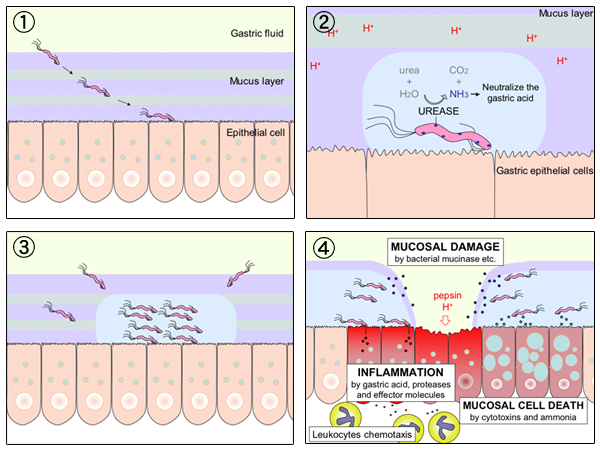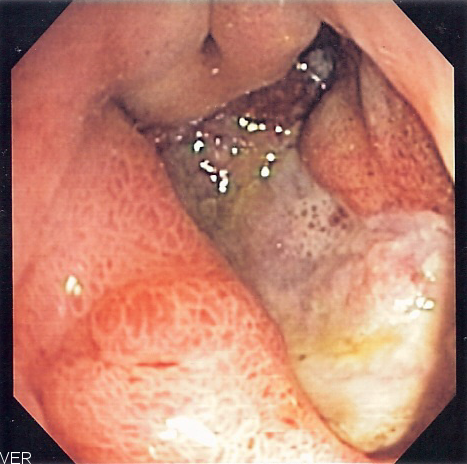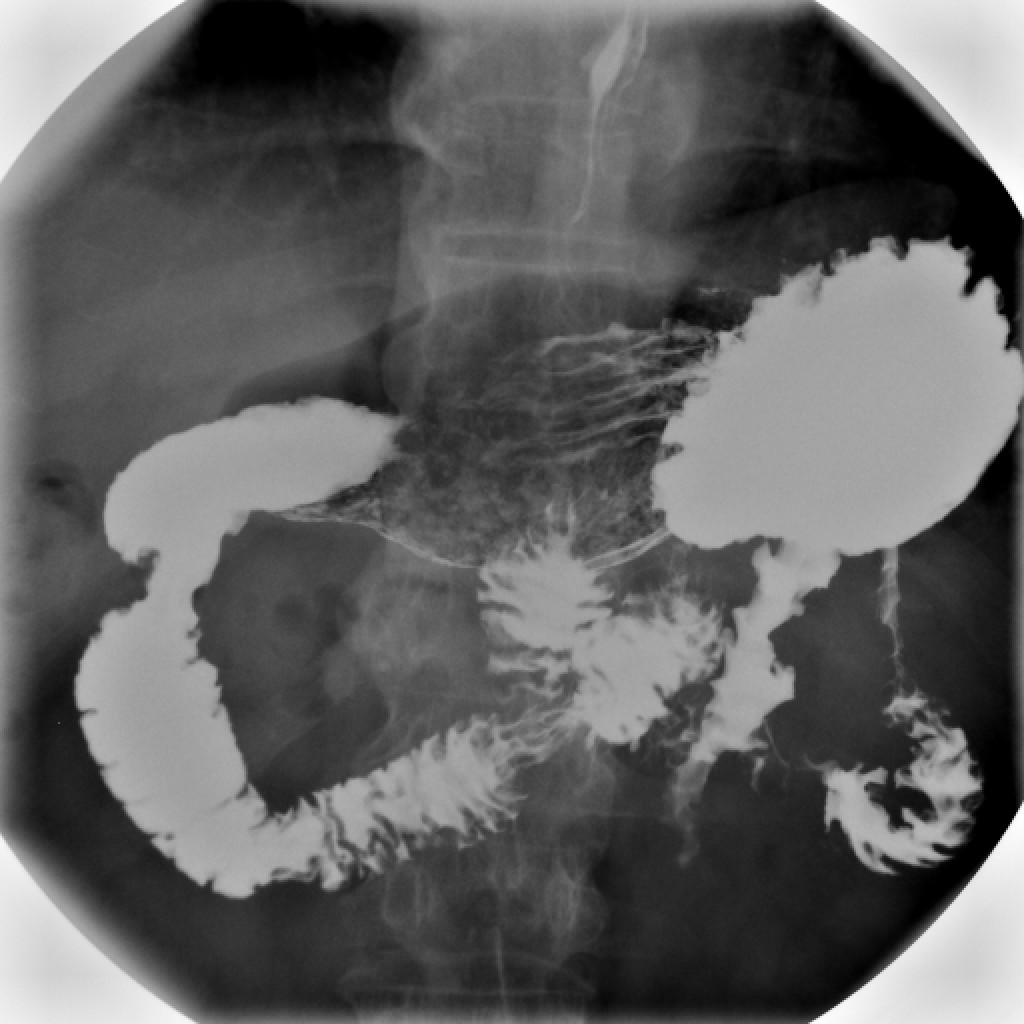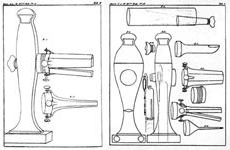|
Gastritis
Gastritis is the inflammation of the lining of the stomach. It may occur as a short episode or may be of a long duration. There may be no symptoms but, when symptoms are present, the most common is upper abdominal pain (see dyspepsia). Other possible symptoms include nausea and vomiting, bloating, loss of appetite and heartburn. Complications may include stomach bleeding, stomach ulcers, and stomach tumors. When due to autoimmune problems, low red blood cells due to not enough vitamin B12 may occur, a condition known as pernicious anemia. Common causes include infection with '' Helicobacter pylori'' and use of nonsteroidal anti-inflammatory drugs ( NSAIDs). When caused by ''H. pylori'' this is now termed ''Helicobacter pylori'' induced gastritis, and included as a listed disease in ICD11. Less common causes include alcohol, smoking, cocaine, severe illness, autoimmune problems, radiation therapy and Crohn's disease. Endoscopy, a type of X-ray known as an upper gast ... [...More Info...] [...Related Items...] OR: [Wikipedia] [Google] [Baidu] |
Helicobacter Pylori
''Helicobacter pylori'', previously known as ''Campylobacter pylori'', is a gram-negative, Flagellum#bacterial, flagellated, Bacterial cellular morphologies#Helical, helical bacterium. Mutants can have a rod or curved rod shape that exhibits less virulence. Its Helix, helical body (from which the genus name ''Helicobacter'' derives) is thought to have evolved to penetrate the gastric mucosa, mucous lining of the stomach, helped by its flagella, and thereby establish infection. While many earlier reports of an association between bacteria and the ulcers had existed, such as the works of John Lykoudis, it was only in 1983 when the bacterium was formally described for the first time in the English-language Western literature as the causal agent of peptic ulcer, gastric ulcers by Australian physician-scientists Barry Marshall and Robin Warren. In 2005, the pair was awarded the Nobel Prize in Physiology or Medicine for their discovery. Infection of the stomach with ''H. pylori'' doe ... [...More Info...] [...Related Items...] OR: [Wikipedia] [Google] [Baidu] |
Pernicious Anemia
Pernicious anemia is a disease where not enough red blood cells are produced due to a deficiency of Vitamin B12, vitamin B12. Those affected often have a gradual onset. The most common initial symptoms are Fatigue, feeling tired and weak. Other symptoms may include shortness of breath, feeling faint, a smooth red tongue, Pallor, pale skin, chest pain, nausea and vomiting, loss of appetite, heartburn, numbness in the hands and feet, Ataxia, difficulty walking, memory loss, muscle weakness, poor reflexes, blurred vision, clumsiness, depression, and confusion. Without treatment, some of these problems may become permanent. Pernicious anemia refers to a type of Vitamin B12 deficiency, vitamin B12 deficiency anemia that results from lack of intrinsic factor. Lack of intrinsic factor is most commonly due to an autoimmune attack on the Parietal cells, cells that create it in the stomach. It can also occur following the surgical removal of all or part of the stomach or small intestine; ... [...More Info...] [...Related Items...] OR: [Wikipedia] [Google] [Baidu] |
Peptic Ulcer
Peptic ulcer disease is when the inner part of the stomach's gastric mucosa (lining of the stomach), the first part of the small intestine, or sometimes the lower esophagus, gets damaged. An ulcer in the stomach is called a gastric ulcer, while one in the first part of the intestines is a duodenal ulcer. The most common symptoms of a duodenal ulcer are waking at night with epigastrium, upper abdominal pain, and upper abdominal pain that improves with eating. With a gastric ulcer, the pain may worsen with eating. The pain is often described as a dyspepsia, burning or dull ache. Other symptoms include belching, vomiting, weight loss, or Anorexia (symptom), poor appetite. About a third of older people with peptic ulcers have no symptoms. Complications may include gastrointestinal bleeding, bleeding, gastrointestinal perforation, perforation, and gastric outlet obstruction, blockage of the stomach. Bleeding occurs in as many as 15% of cases. Common causes include infection with ''Hel ... [...More Info...] [...Related Items...] OR: [Wikipedia] [Google] [Baidu] |
Peptic Ulcer Disease
Peptic ulcer disease is when the inner part of the stomach's gastric mucosa (lining of the stomach), the first part of the small intestine, or sometimes the lower esophagus, gets damaged. An ulcer in the stomach is called a gastric ulcer, while one in the first part of the intestines is a duodenal ulcer. The most common symptoms of a duodenal ulcer are waking at night with upper abdominal pain, and upper abdominal pain that improves with eating. With a gastric ulcer, the pain may worsen with eating. The pain is often described as a burning or dull ache. Other symptoms include belching, vomiting, weight loss, or poor appetite. About a third of older people with peptic ulcers have no symptoms. Complications may include bleeding, perforation, and blockage of the stomach. Bleeding occurs in as many as 15% of cases. Common causes include infection with ''Helicobacter pylori'' and non-steroidal anti-inflammatory drugs (NSAIDs). Other, less common causes include tobacco smoking, ... [...More Info...] [...Related Items...] OR: [Wikipedia] [Google] [Baidu] |
Abdominal Pain
Abdominal pain, also known as a stomach ache, is a symptom associated with both non-serious and serious medical issues. Since the abdomen contains most of the body's vital organs, it can be an indicator of a wide variety of diseases. Given that, approaching the examination of a person and planning of a differential diagnosis is extremely important. Common causes of pain in the abdomen include gastroenteritis and irritable bowel syndrome. About 15% of people have a more serious underlying condition such as appendicitis, leaking or ruptured abdominal aortic aneurysm, diverticulitis, or ectopic pregnancy. In a third of cases, the exact cause is unclear. Signs and symptoms The onset of abdominal pain can be abrupt, quick, or gradual. Sudden onset pain happens in a split second. Rapidly onset pain starts mild and gets worse over the next few minutes. Pain that gradually intensifies only after several hours or even days has passed is referred to as gradual onset pain. One can ... [...More Info...] [...Related Items...] OR: [Wikipedia] [Google] [Baidu] |
Sucralfate
Sucralfate, sold under various brand names, is a medication used to treat stomach ulcers, gastroesophageal reflux disease (GERD), radiation proctitis, and stomach inflammation and to prevent stress ulcers. Its usefulness in people infected by '' H. pylori'' is limited. It is used by mouth (for upper GIT ulcers) and rectally (for radiation proctitis). Common side effects include constipation. Serious side effects may include bezoar formation and encephalopathy. Use appears to be safe in pregnancy and breastfeeding. How it works is unclear but is believed to involve binding to the ulcer and protecting it from further damage. Sucralfate was approved for medical use in the United States in 1981. It is available as a generic medication. In 2022, it was the 214th most commonly prescribed medication in the United States, with more than 1million prescriptions. Medical uses Sucralfate is used for the treatment of active duodenal ulcers not related to the use of nonsteroidal anti- ... [...More Info...] [...Related Items...] OR: [Wikipedia] [Google] [Baidu] |
Upper Gastrointestinal Series
An upper gastrointestinal series, also called a barium swallow, barium study, or barium meal, is a series of radiographs used to examine the gastrointestinal tract for abnormalities. A contrast medium, usually a radiocontrast agent such as barium sulfate mixed with water, is ingested or instilled into the gastrointestinal tract, and X-rays are used to create radiographs of the regions of interest. The barium enhances the visibility of the relevant parts of the gastrointestinal tract by coating the inside wall of the tract and appearing white on the film. This in combination with other plain radiographs allows for the imaging of parts of the upper gastrointestinal tract such as the pharynx, larynx, esophagus, stomach, and small intestine such that the inside wall lining, size, shape, contour, and patency are visible to the examiner. With fluoroscopy, it is also possible to visualize the functional movement of examined organs such as swallowing, peristalsis, or sphincter closure. De ... [...More Info...] [...Related Items...] OR: [Wikipedia] [Google] [Baidu] |
Proton Pump Inhibitors
Proton-pump inhibitors (PPIs) are a class of medications that cause a profound and prolonged reduction of gastric acid, stomach acid production. They do so by irreversibly inhibiting the stomach's H+/K+ ATPase, H+/K+ ATPase proton pump. The body eventually synthesizes new proton pumps to replace the irreversibly inhibited ones, a process driven by normal cellular turnover, which gradually restores acid production. Proton-pump inhibitors have largely superseded the H2-receptor antagonist, H2-receptor antagonists, a group of medications with similar effects but a different mode of action, and heavy use of antacids. A potassium-competitive acid blocker (PCAB) revaprazan was marketed in Korea as an alternative to a PPI. A newer PCAB vonoprazan with a faster and longer lasting action than revaprazan, and PPIs has been marketed in Japan (2013), Russia (2021), and the US (2023). PPIs are among the most widely sold medications in the world. The class of proton-pump inhibitor medication ... [...More Info...] [...Related Items...] OR: [Wikipedia] [Google] [Baidu] |
Bismuth Subsalicylate
Bismuth subsalicylate, sold generically as pink bismuth and under brand names including Pepto-Bismol, Pepti-Calm, and BisBacter, is a medication used to treat temporary discomfort of the stomach and gastrointestinal tract. This includes an upset stomach, heartburn, or other similar symptoms. Bismuth subsalicylate has the empirical chemical formula C7H5BiO4, and is a colloidal substance obtained by hydrolysis of bismuth salicylate (Bi(C6H4(OH)CO2)3). Medical uses As a derivative of salicylic acid, bismuth subsalicylate displays anti-inflammatory and bactericidal action. It also acts as an antacid. Mechanism of action Bismuth subsalicylate is used as an antacid and antidiarrheal, and to treat some other gastrointestinal symptoms, such as nausea. The means by which this occurs is still not well documented. It is thought to be some combination of the following: [...More Info...] [...Related Items...] OR: [Wikipedia] [Google] [Baidu] |
Heartburn
Heartburn is a burning sensation felt behind the breastbone. It is a symptom that is commonly linked to acid reflux and is often triggered by food, particularly fatty, sugary, spicy, chocolate, citrus, onion-based and tomato-based products. Lying down, bending, lifting, and performing certain exercises can exacerbate heartburn. Causes include acid reflux, gastroesophageal reflux disease (GERD), damage to the esophageal lining, bile acid, mechanical stimulation to the esophagus, and esophageal hypersensitivity. Heartburn affects 25% of the population at least once a month. Endoscopy and esophageal pH monitoring can be used to evaluate heartburn. Some causes of heartburn, such as GERD, may be diagnosed based on symptoms alone. Potential Differential diagnosis, differential diagnoses for heartburn include motility disorders, ulcers, Esophagitis, inflammation of the esophagus, and medication side effects. Lifestyle changes, such as weight loss, losing weight and avoiding fatty food ... [...More Info...] [...Related Items...] OR: [Wikipedia] [Google] [Baidu] |
Nausea
Nausea is a diffuse sensation of unease and discomfort, sometimes perceived as an urge to vomit. It can be a debilitating symptom if prolonged and has been described as placing discomfort on the chest, abdomen, or back of the throat. Over 30 definitions of nausea were proposed in a 2011 book on the topic. Nausea is a non-specific symptom, which means that it has many possible causes. Some common causes of nausea are gastroenteritis and other gastrointestinal disorders, food poisoning, motion sickness, dizziness, migraine, fainting, low blood sugar, anxiety, hyperthermia, dehydration and lack of sleep. Nausea is a side effect of many medications including chemotherapy, or morning sickness in early pregnancy. Nausea may also be caused by disgust and depression. Medications taken to prevent and treat nausea and vomiting are called antiemetics. The most commonly prescribed antiemetics in the US are promethazine, metoclopramide, and the newer ondansetron. The word na ... [...More Info...] [...Related Items...] OR: [Wikipedia] [Google] [Baidu] |
Gastroenterology
Gastroenterology (from the Greek gastḗr- "belly", -énteron "intestine", and -logía "study of") is the branch of medicine focused on the digestive system and its disorders. The digestive system consists of the gastrointestinal tract, sometimes referred to as the ''GI tract,'' which includes the esophagus, stomach, small intestine and large intestine as well as the accessory organs of digestion which include the pancreas, gallbladder, and liver. The digestive system functions to move material through the GI tract via peristalsis, break down that material via digestion, absorb nutrients for use throughout the body, and remove waste from the body via defecation. Physicians who specialize in the medical specialty of gastroenterology are called gastroenterologists or sometimes ''GI doctors''. Some of the most common conditions managed by gastroenterologists include gastroesophageal reflux disease, gastrointestinal bleeding, irritable bowel syndrome, inflammatory bowel disease (IBD ... [...More Info...] [...Related Items...] OR: [Wikipedia] [Google] [Baidu] |







